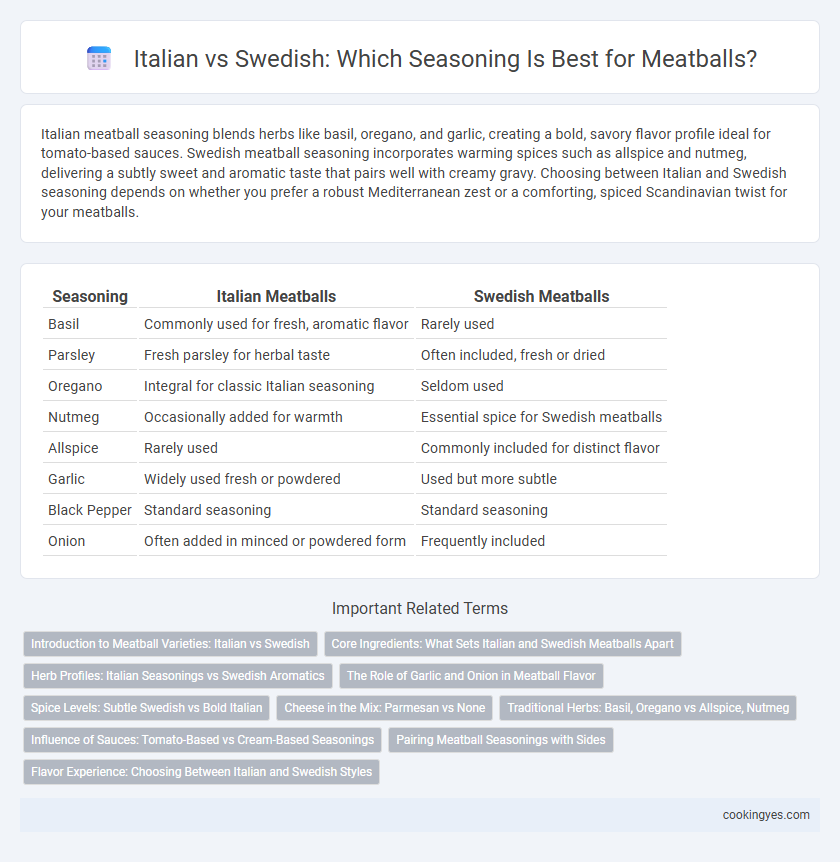Italian meatball seasoning blends herbs like basil, oregano, and garlic, creating a bold, savory flavor profile ideal for tomato-based sauces. Swedish meatball seasoning incorporates warming spices such as allspice and nutmeg, delivering a subtly sweet and aromatic taste that pairs well with creamy gravy. Choosing between Italian and Swedish seasoning depends on whether you prefer a robust Mediterranean zest or a comforting, spiced Scandinavian twist for your meatballs.
Table of Comparison
| Seasoning | Italian Meatballs | Swedish Meatballs |
|---|---|---|
| Basil | Commonly used for fresh, aromatic flavor | Rarely used |
| Parsley | Fresh parsley for herbal taste | Often included, fresh or dried |
| Oregano | Integral for classic Italian seasoning | Seldom used |
| Nutmeg | Occasionally added for warmth | Essential spice for Swedish meatballs |
| Allspice | Rarely used | Commonly included for distinct flavor |
| Garlic | Widely used fresh or powdered | Used but more subtle |
| Black Pepper | Standard seasoning | Standard seasoning |
| Onion | Often added in minced or powdered form | Frequently included |
Introduction to Meatball Varieties: Italian vs Swedish
Italian meatball seasoning features a robust blend of garlic, parsley, Parmesan cheese, and oregano, creating a rich, aromatic profile that complements tomato-based sauces. Swedish meatballs are distinguished by a mild seasoning mix of allspice and nutmeg, delivering a subtle warmth paired with creamy gravy. Both varieties highlight regional herbs and spices, reflecting traditional culinary practices and distinct flavor preferences.
Core Ingredients: What Sets Italian and Swedish Meatballs Apart
Italian meatball seasoning centers on garlic, parsley, and Parmesan cheese, delivering a robust, savory profile with hints of oregano and basil. Swedish meatballs emphasize warm spices like allspice and nutmeg, combined with white pepper and mild onions to create a subtly sweet, aromatic flavor. The core ingredient contrast defines Italian meatballs as herbaceous and tangy, while Swedish varieties lean toward creamy and spiced warmth.
Herb Profiles: Italian Seasonings vs Swedish Aromatics
Italian meatball seasoning emphasizes robust herb profiles like basil, oregano, and parsley, creating a fragrant and savory flavor base often enhanced by garlic and Parmesan. Swedish meatballs rely on aromatic herbs such as allspice, nutmeg, and mild parsley, delivering a warm, subtly sweet, and earthy taste that complements creamy sauces. The contrast between the Italian herbaceous zest and the Swedish warm spice blend defines their distinctive regional meatball identities.
The Role of Garlic and Onion in Meatball Flavor
Italian meatball seasoning typically features garlic and onion as primary ingredients, providing a robust and aromatic base that enhances the rich flavors of beef, pork, and herbs like parsley and oregano. Swedish meatballs incorporate garlic and onion in smaller amounts, often combined with warming spices such as allspice and nutmeg, resulting in a milder, subtly sweet profile. The balanced use of garlic and onion in both traditions significantly influences the savory depth and overall complexity of the meatball's taste.
Spice Levels: Subtle Swedish vs Bold Italian
Swedish meatballs feature a subtle spice profile, typically incorporating allspice and white pepper for a mild, warming flavor that complements creamy sauces. In contrast, Italian meatballs boast bold seasoning with garlic, oregano, and crushed red pepper, delivering a robust and slightly spicy taste. The distinct spice levels define the culinary identity of each cuisine's approach to meatball seasoning.
Cheese in the Mix: Parmesan vs None
Italian meatballs often incorporate Parmesan cheese, adding a rich, nutty flavor and enhancing the overall umami profile, while Swedish meatballs traditionally exclude cheese, relying instead on spices like allspice and nutmeg for their distinctive taste. The presence of Parmesan in Italian seasoning blends contributes to a denser texture and a more complex depth, contrasting with the smoother, creamier consistency of Swedish meatballs. Cheese inclusion not only affects flavor but also moisture retention, making Parmesan a key differentiator between Italian and Swedish meatball seasoning.
Traditional Herbs: Basil, Oregano vs Allspice, Nutmeg
Traditional Italian meatballs often feature a fragrant blend of basil and oregano, infusing the meat with aromatic Mediterranean herbs that enhance the savory flavor profile. In contrast, Swedish meatballs are typically seasoned with warm spices like allspice and nutmeg, creating a subtle sweetness and complexity that complements creamy sauces. These distinct herb and spice choices reflect the cultural origins and cooking styles unique to each meatball variety.
Influence of Sauces: Tomato-Based vs Cream-Based Seasonings
Italian meatballs commonly feature tomato-based seasonings, with robust herbs like basil, oregano, and garlic enhancing the sauce's acidity and sweetness. Swedish meatballs rely on cream-based sauces that incorporate ingredients like sour cream, white pepper, and allspice, creating a rich and mildly spiced flavor profile. The sauce choice significantly influences the seasoning blend, balancing acidity in Italian recipes and adding smoothness and warmth in Swedish variations.
Pairing Meatball Seasonings with Sides
Italian meatball seasoning blends garlic, basil, oregano, and Parmesan, perfectly pairing with sides like spaghetti marinara and garlic bread to enhance robust Mediterranean flavors. Swedish meatball seasoning incorporates allspice, nutmeg, and white pepper, harmonizing with creamy mashed potatoes and lingonberry sauce for a comforting, subtly spiced profile. Selecting seasoning based on regional spices ensures complementary side dishes that elevate the overall dining experience.
Flavor Experience: Choosing Between Italian and Swedish Styles
Italian meatball seasoning features robust herbs like basil, oregano, and parsley, combined with garlic and Parmesan, offering a rich, savory, and slightly tangy flavor profile. Swedish meatballs rely on warm spices such as allspice and nutmeg, enhanced with cream and mustard, creating a comforting, mildly sweet, and aromatic taste. Selecting between these styles depends on whether you prefer vibrant Mediterranean herbs or cozy Scandinavian warmth in your meatball seasoning.
Italian vs Swedish for Meatball Seasoning Infographic

 cookingyes.com
cookingyes.com